Description
Leptosiphon bolanderi is an annual herb producing a hairy, threadlike stem no more than about 20 centimeters tall. The oppositely arranged leaves are each divided into very narrow needlelike lobes just a few millimeters long.
The tip of the stem has an inflorescence of usually a single flower with a tubular purple or pink throat tinted yellow inside and enclosed in glandular sepals. The corolla has white or pink lobes a few millimeters wide. The bloom period is from March to July, depending on elevation and latitude.

Linanthus is a genus of annual and perennial plants in the phlox family Polemoniaceae. The species are found in western North America and in Chile, with the greatest diversity in California.
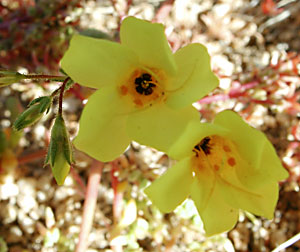
Leptosiphon is a genus of flowering plants in the Polemoniaceae family. Many included species were formerly classified as members of the genus Linanthus. Some species of this genus are grown as ornamental plants.

Helenium bolanderi is a North American species of flowering plant in the daisy family known by the common name coastal sneezeweed. It is native to southern Oregon and northern California as far south as Mendocino County, primarily along the seacoast.

Helianthus bolanderi is a species of sunflower known by the common names Bolander's sunflower and serpentine sunflower. It is native to California and Oregon, where it grows mainly in mountainous areas, often in serpentine soils. It has been found from southwestern Oregon as well as in northern and central California as far south as Santa Cruz County, with reports of a few isolated populations in southern California.
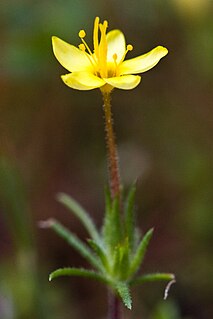
Leptosiphon acicularis is a species of flowering plant in the phlox family known by the common names bristly linanthus and bristly leptosiphon.

Leptosiphon androsaceus is a species of flowering plant in the phlox family known by the common name false babystars.

Leptosiphon ciliatus is a species of flowering plant in the phlox family known by the common name whiskerbrush.
Leptosiphon filipes is a species of flowering plant in the phlox family known by the common name thread linanthus.

Leptosiphon grandiflorus is a species of flowering plant in the phlox family known by the common names large-flower linanthus and large flowered leptosiphon.
Linanthus killipii, known by the common name Baldwin Lake linanthus, is a rare species of flowering plant in the phlox family.
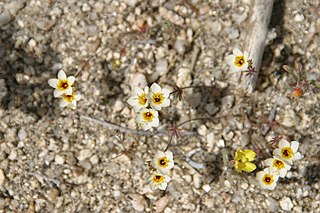
Leptosiphon lemmonii is a species of flowering plant in the phlox family known by the common name Lemmon's linanthus.

Leptosiphon montanus is a species of flowering plant in the phlox family known by the common name mustang clover.
Leptosiphon nudatus is a species of flowering plant in the phlox family known by the common name Tehachapi linanthus.

Leptosiphon nuttallii is a species of flowering plant in the phlox family known by the common name Nuttall's linanthus.
Leptosiphon oblanceolatus is a species of flowering plant in the phlox family known by the common name Sierra Nevada linanthus.
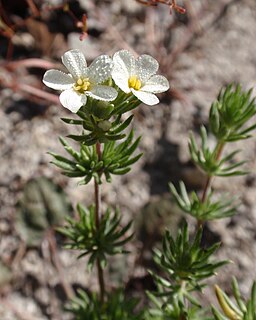
Leptosiphon pachyphyllus is a species of flowering plant in the phlox family, known by the common name Sierra linanthus.
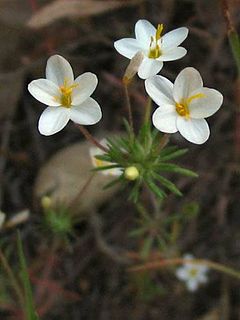
Leptosiphon parviflorus is a species of flowering plant in the phlox family known by the common name variable linanthus.

Leptosiphon rattanii is a rare species of flowering plant in the phlox family known by the common name Rattan's linanthus.

Leptosiphon septentrionalis is a species of flowering plant in the phlox family known by the common name northern linanthus.
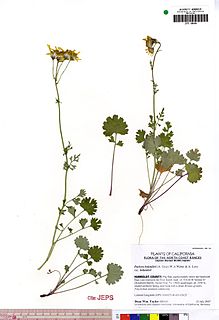
Packera bolanderi is a species of flowering plant in the aster family known by the common names Bolander's ragwort and seacoast ragwort. It is native to the west coast of the United States from Washington to northern California, where it grows in wet coastal forests and woodlands. There are two varieties of the species which differ slightly in morphology and habitat occupied; these varieties have been considered separate species by some authors. The var. bolanderi has thicker leaves, occurs farther south, and occupies more open types of habitat, than does var. harfordii. This plant in general is a perennial herb producing one to three stems up to half a meter tall. The basal leaves have blades up to 12 centimeters long which are divided into several lobes and borne on long, thin petioles. Leaves growing farther up the stem are smaller and have more lobes on their blades. The inflorescence contains several flower heads, each lined with dark green phyllaries. The head contains many golden yellow disc florets and generally either 8 or 13 yellow ray florets each over a centimeter long. The fruit is an achene tipped with a pappus of bristles.
This page is based on this
Wikipedia article Text is available under the
CC BY-SA 4.0 license; additional terms may apply.
Images, videos and audio are available under their respective licenses.















